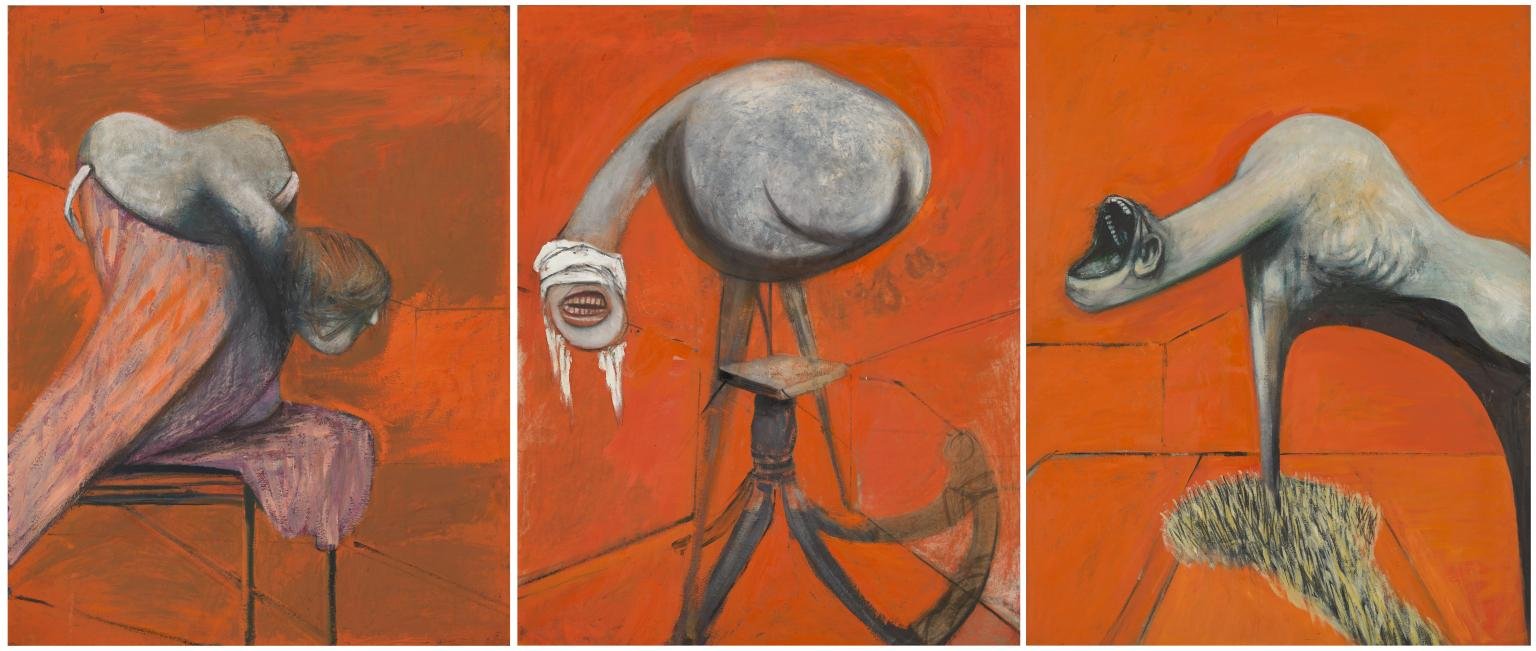The haunting imagery of Francis Bacon’s most famous triptych
Triptych – an artwork composed of three correlated panels – originates from Christian art and thus often speaks on religious themes. In this regard, Francis Bacon’s Three Studies for Figures at the Base of a Crucifixion (1944) could fit the description – if only it actually was about the biblical story.
Francis Bacon (1909-1992), Dublin-born British artist, was forced to leave his home for England at the age of sixteen following a fallout with his father when the latter found out about Bacon’s homosexuality. A handsome young man, he attracted preying older men who initially sponsored his lifestyle of drinking and gambling. Young Bacon briefly lived in France when he saw Picasso’s exhibition – this was when he first picked up watercolours and started painting – sans any schooling or guidance. At the time he pursued a career as an interior and furniture designer – in fact, his first exhibition combined paintings and rugs of his own design. Apart from Picasso, his other sources of inspiration were Velasquez and Van Gogh, as well as cinema and photography – the still of a screaming woman from Eisenstein’s Battleship Potemkin feature film (1925) especially held power over him and impacted his work; so did medical journals, which can be traced in the detail given to the depiction of mouth, also traced in his famous triptych.
Francis Bacon in his studio
Bacon is often considered to be a part of the School of London - post-war British school of art, which, though it did not boast a recognizable or instantly identifiable style, most closely leaned to expressionism. The naked human body at the center – but not praised, celebrated or adorned, but beaten, raw, vulnerable, and neurotic in a deeply existentialist manner. Apart from Bacon, the movement was represented by Lucian Freud, Frank Auerbach, Leon Kossoff and others.
Three Studies for Figures at the Base of a Crucifixion
Three Studies for Figures at the Base of a Crucifixion first saw light in London’s Lefevre Gallery in 1945 and can now be found at Tate London. The triptych is considered Bacon’s artistic breakthrough; it places disturbing, milky-white bodies – or resembling such - against flaming orange backdrop, the contrast being further amplified by sharp, torn gray shadows – a technique that Bacon would eventually abandon in favor of impasto. The painter’s eyeless figures are terrifying, they are strangely anxiety-ridden - we find very similar portrayals of humanoid monsters in horror films – for instance, The Pale Man in 2006 Spanish dark fantasy Pan’s Labyrinth. The three figures are suffering in strange, distorted poses, very detached from any sort of human anatomy, shrieking as if subjected to excruciating pain. Bacon’s figures could have been magnified characters from one of Hieronymus Bosch’s Garden of Earthly Delights (1505) – yet Bacon’s triptych creates an even stronger sense of nausea, with even less paradisiacal message. Bacon, in fact, drew inspiration from Aeschylus’ Oresteia, a frequent theme that often reemerged in his work, the three creatures referring to the Furies. So, The Three Studies… does not actually depict crucifixion, which is not even observed in any of the three paintings – it is, in fact, a disturbing reflection on the sufferings of war. Bacon was apparently deeply traumatised by World War II and, reportedly, devastated by the news spreading about Nazi death camps. In Bacon’s triptych, the war attains a quasi-biblical importance. The ghost of war – already not entirely present – however still ignites pain and human suffering, as unimaginable and never-before-seen as the distorted movements of Bacon’s unsettling creatures.

